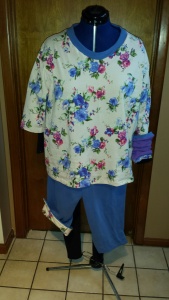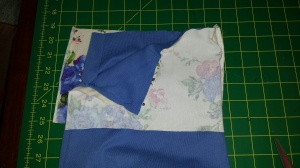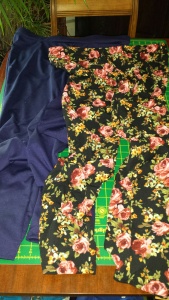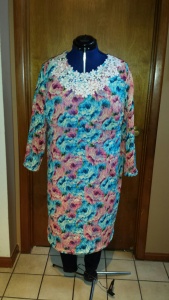 I needed a nice dress for a black tie optional wedding in Charleston, SC. The azaleas, rhododendrons and wisteria were in bloom. I realized the dark, short dress I planned to wear just wouldn’t work. So I made a different dress, McCalls 2501.
I needed a nice dress for a black tie optional wedding in Charleston, SC. The azaleas, rhododendrons and wisteria were in bloom. I realized the dark, short dress I planned to wear just wouldn’t work. So I made a different dress, McCalls 2501.
Then I got the most amazing silk charmeuse burn out chiffon, from Fabric Mart. I had to use it! The large scale, purple floral print is shot through with metallic gold. I loved it! And it went on sale again day after my first piece arrived! So I promptly ordered 8 more yards and began searching for a dress pattern.
Vogue 7876 popped up in a thread somewhere on the PR forums. I loved the drape along the wrap front. Several high end formals from high end stores are showing drapes, particularly over the arms or in the back. I decided to make view E, with long sleeves, extend the blouse into a drop waist bodice with a full circle skirt, and maybe add a drape in back.
This modified design gobbled fabric. A lot of fabric!
 My original plan was to line the bodice and skirt with silk habotai, leaving the sleeves sheer. So I started by cutting two half circles of white silk. I’ve made many circle, circle and a half, and double circle skirts for belly dancing costumes. So I know two important things about working with half circles. First, they stretch on the bias at the waist. Second, they stretch on the bias at the hem.
My original plan was to line the bodice and skirt with silk habotai, leaving the sleeves sheer. So I started by cutting two half circles of white silk. I’ve made many circle, circle and a half, and double circle skirts for belly dancing costumes. So I know two important things about working with half circles. First, they stretch on the bias at the waist. Second, they stretch on the bias at the hem.
Normally I promptly stay stitch near the cut edge of the waist with a short (2.0) stitch to prevent stretching. But, this time I actually wanted a little stretch. I needed the skirt to over lap in front. My plan was to line up the circle skirt center seam with the center back, then stretch the waist edge enough to wrap around the front.
Next I cut the back blouse/bodice, both front pieces, and one test sleeve out of the white silk. Normally I need to do FBA, but there didn’t seem to be an easy way to do it on this pattern. So I ended up messing with the shoulders and armholes instead. This might have been a bad move on my part, but who knows which way would have been best.
I also made it a part faux wrap. I extended the under front piece a few inches, and sewed the raw edge into the side seam. This makes the dress a pullover with a wrap across the front. So even if the worst does happen – the wrap comes out – I’m still covered! LOL!
After quite a bit of tweaking I was satisfied with the fit of the silk bodice. I took it apart and used the bodice pieces and one of the half circles as the pattern pieces for the purple chiffon. The fabric arrived on Monday, we left on Tuesday the following week. Not much time!
I cut the skirt half circles first. French seams would be nice, but, this is the THIRD dress so I’m really pressed for time. So I serged finished the seams and even sewed a few directly on the serger! Two of those seams were the center back seams on the purple chiffon and white silk skirts. I set them to one side.
I tried to get the sleeves out of the scraps from the circle skirt, but the fabric pieces just weren’t big enough. I set the scraps aside to use for the drape and tie pieces.
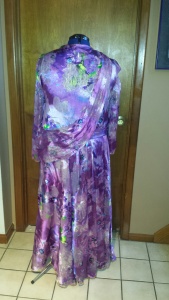 Next I cut the blouse front and back and sleeves from the remaining fabric. I used up the second 8 yards, and started cutting into my first 3 yard piece. YIKES now I’ll have to order more before it’s gone!
Next I cut the blouse front and back and sleeves from the remaining fabric. I used up the second 8 yards, and started cutting into my first 3 yard piece. YIKES now I’ll have to order more before it’s gone!
I basted the bodice seams on the machine. When I was satisfied I serged them. I stay stitched along the raw front neck edge, to keep the bias from stretching.
Right about here I was feeling the time crunch. I abandoned the idea of trying to line the dress. But, it was too sheer without something. So the lining pieces became a separate slip.
I cut the facings and ties and two of the front collar drapes. One for the front like the pattern, the second across the back. I applied interfacing to the facings. The pattern calls for a narrow rolled hem on the raw edges of the ties and collar drape.
I used the serger for this step. I used a three thread rolled hem stitch, with gold metallic thread in the loopers and a burgundy metallic in the needle. Later on, when I did the hem, I used a variegated purple embroidery thread in the needle. I wish I had thought of that instead of the burgundy metallic, because all three metallic threads together makes a stiff edge.
Serger tutorials and instruction manuals say to disengage the blade when making a rolled hem. But, I saw one instructor (maybe Angela Wolfe?) leave the blade engaged. It did no harm, and trimmed away tiny whiskers that would otherwise need to be trimmed away by hand.
Because the serger was already set up, I went ahead and finished the exposed edge of the skirt (the edge along the side that wraps around the front) the same way. The unexposed (hidden under the wrap) edge is left with selvedge finish.
I added the front drape collar, then the facings according to the pattern instructions. I sewed the tie ends in place.
Next I attached the skirt to the bodice. It makes more sense to insert the sleeves before attaching the skirt, because the skirt adds a lot of bulk to maneuver around the sewing machine. But I didn’t.
I did not notice that the lower edge of the bodice was NOT cut straight on the grain. This soft silk fabric feels lighter than air when worn, but in fact it does have weight. Enough weight to pull and distort the bodice front. I couldn’t figure out what was going wrong!
When I realized what was happening, I corrected the problem as best I could by stabilizing the waist seam with twill tape. I did the same thing to the slip, but because I had no white twill tape or seam binding, I used tan. Not the prettiest look, but then again, this slip is not my best sewing.
I also added a second tie at the waist to help everything stay in place. To do this, I cut and finished two more tie ends.
But, the waist seam still didn’t look good. I decided to hide it with a narrow self fabric belt, stitched in place at the side seams and front edges. Then I sewed the wide edge of the back drape to the right shoulder, and left it hang free. I can wear it like that, or tuck it into the belt.
Finally it’s time for the sleeves. I sewed the sleeve seams directly on the serger. I machine basted them in place, then finished those seams on the serger.
The last step was to hem the skirt and sleeves. A rolled hem would be nice, but applying a narrow rolled hem to a circle skirt can be a real struggle. So I opted for a different decorative serger finish. I used a wide three thread overlock stitch and a fairly short (less than 1 but more than 0) stitch length. I put variegated purple embroidery thread in the needle and gold metallic thread in the loopers.
Hemming the sleeves was quick and easy. I just put the dress on, marked the desired length with a couple of straight pins, and cut them off a smidge below. Then I finished them on the serger with the decorative stitch.
The bias sections of a circle skirt hem relax over time, making the hem uneven. The ideal way to prevent this is to dampen the skirt (if the fabric can handle it) and let it hang for several days to let the bias relax. I did not have several days. I had overnight, only. So, I hung the dress overnight.
To hem the dress I put Dolly the Dress Form on top of some big plastic bins. Then, I put the dress on her. I was surprised at how crazy the hem was, even though it hung only one night. I found the shortest point of the hem, and carefully snipped the hem up to that length all the way around. I was not super precise, I simply eyeballed it. The fullness of the skirt and the long length will disguise minor wobbles (but big ones will still be obviously visible). I used the same serged finish on the skirt that I’d used on the sleeves.
Then I finished the slip. I added a waist stay from tan seam binding. I cut the neck opening bigger so it won’t every peek out, even by accident, and finished it with an ordinary 4 thread serger stitch. I put the slip on Dolly. I snipped the hem at what I thought was a few inches shorter than the skirt. I tried the slip on under the dress, and it came out exactly as I hoped, a couple inches shorter than the dress. I finished the hem with an ordinary 4 thread serger stitch.
This dress and slip are so light and airy it’s like wearing a bathrobe!
My only dislike is the tie ends. The single layer of chiffon is kind of thin and limp for this purpose, and the stiff rigid metallic rolled hem I applied doesn’t help. The ties kept untying until I tied them in a knot on top of a bow. Then they stayed nicely in place, but were nearly impossible to untie. I have some long, narrow scraps left from the skirt section. I might remove the current ends from the dress and double them up with a second set of ends cut from the scraps, and finish the edges with the same wide finish I used on the hem, instead of the narrow rolled metallic hem. I might also add hooks and eyes to support the stress of keeping things closed and let the ties be simply decorative.
If I make this top again I will try to do a regular FBA.
<b>Pattern Description: </b>
Wrap top with optional draped collar and sleeve choices
<b>Pattern Sizing:</b>
Misses
<b>Did it look like the photo/drawing on the pattern envelope once you were done sewing with it?</b>
I made changes, so not so much
<b>Were the instructions easy to follow?</b>
Yes
<b>What did you particularly like or dislike about the pattern?</b>
Like the wrap
<b>Fabric Used:</b>
Silk burn out chiffon
<b>Pattern alterations or any design changes you made:</b>
Added a circle skirt, extra tie at the dropped waist, and a back drape
<b>Would you sew it again? Would you recommend it to others?</b>
I might, but as a top not as a dress. Yes I recommend it

